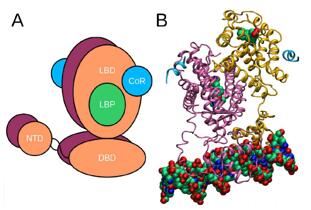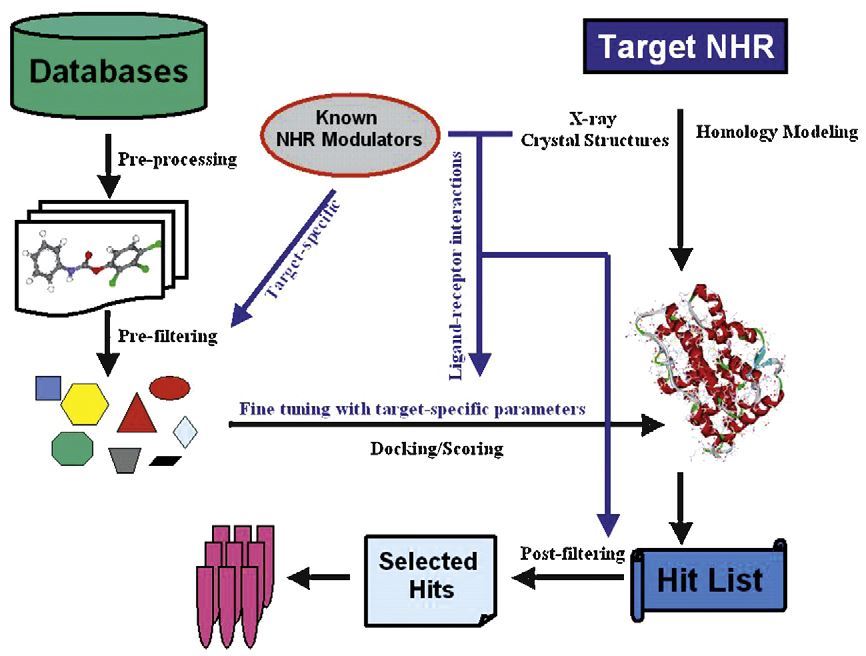Nuclear receptors (NRs) are one of the largest groups of transcription factors that are extensively distributed in the body and expressed in the cytoplasm or nucleus. There are more than 200 known NR proteins that play an important role in a bunch of biological processes, including proliferation, differentiation, metabolism, apoptosis, inflammation, and immune responses. Disorders in the expression of NRs or their regulated genes could result in conditions such as diabetes, reproductive system diseases, cardiovascular diseases, and even cancers. As a professional service provider with abundant experience, Creative Biolabs offers comprehensive computational pharmacology services, especially structure-based receptor modeling for reproductive research, to help global customers advance their projects.
 Fig.1 Assembly of NRs and their interaction partners. (Kronenberger, 2015)
Fig.1 Assembly of NRs and their interaction partners. (Kronenberger, 2015)
The NR superfamily contains the receptors for steroid hormones (e.g. progesterone receptor (PR), estrogen receptor (ER), glucocorticoid receptor (GR), androgen receptor (AR)), thyroid hormone, lipophilic vitamins, and cholesterol metabolites, most of which function as a ligand-independent fashion. Approximate half of NRs are divided into as orphan receptors since they don’t have well-characterized ligands.
Virtually, NRs have identified ligands that are promising targets for the development of drugs to treat myriad diseases, including reproductive disorders. For example, molecules such as tamoxifen for ER used for breast cancer, mifepristone for PR used for fertility, and dexamethasone for GR used for inflammatory diseases, are among the prominent cases of prescription drugs that target NRs.
 Fig.2 A virtual screening scheme for NRs. (Ai, 2009)
Fig.2 A virtual screening scheme for NRs. (Ai, 2009)
The reproductive system coordinates signaling pathways in a diversity of cell types which leads to oogenesis and spermatogenesis, ovulation, menstruation, implantation, and finally childbirth. Precise regulation of this cellular communication signaling is essential for normal development and fertility in humans. NRs are valuable therapeutic targets for reproductive drug discovery as these receptors control key physiological processes and their dysfunction underlies many pathological situations associated with infertility and disease.
Understanding the NR function requires knowledge of its structure. Both X-ray detection and computational modeling are appropriate tools to address this problem. The composition of NRs is modular and comprises 5-6 domains with distinct functions. All the NRs share common domain architecture of a highly conserved DNA-binding domain (DBD) and a structurally conserved ligand-binding domain (LBD). Other domains display a considerable variation in sequence and length such as the N-terminal domain, the C-terminal domain, as well as the hinge region connecting DBD and LBD. At Creative Biolabs, we take advantage of a framework for quantitative analysis of the ER complex using three-dimensional (3D) protein-ligand interaction combined with the structure-activity relationship approach. Here, we pay attention to several of the most likely candidates that can be exploited for reproductive research.
| AR | ERα | ERβ | GR | PRα |
| RAR | PPAR | NR5A1 | NR5A2 | LRH-1 |
| SF-1 | LXR | VDR | RXR |
Computational methods have been widely applied in order to identify novel agonists or antagonists for NRs. The availability of LBD crystal structures permits the employment of structure-based virtual screening techniques, for instance, molecular docking of virtual compound libraries. If the wanted NR structure isn’t available, homology modeling approaches can be used to collect useful structural data. Because of the highly conserved LBD structure, this method often generates high-quality protein models.
Moreover, orphan receptors work out in the reproductive context to upregulate or suppress gene expression. By this means, they affect a plethora of reproductive events and are considered critical regulators in the reproductive system of mammals. Remarkably, our structural biologists contribute new insights into NR binding domains and promote to adopt these orphan receptors by crystallography.
Members of the NR superfamily regulate diverse aspects of development, homeostasis, reproduction, and immunity in a ligand-dependent manner. The involvement of NRs in different diseases has made these factors highly attractive to the pharmaceutical industry. As a reliable partner in the protein engineering market, Creative Biolabs offers a series of in-silico pharmacology services for reproductive research and many other pathological areas. Our structure-based computational NR modeling can assist clients in better understanding binding affinity and mode of actions regarding desired proteins. If you’d like to acquire more information, please don’t hesitate to contact us.
References
All listed services and products are For Research Use Only. Do Not use in any diagnostic or therapeutic applications.